Illinois << `ihl` uh NOY >> has more people than any other state in the Midwestern region of the United States. About two-thirds of the people of Illinois live in and around Chicago, one of the world’s leading industrial and transportation centers. In addition, millions of Illinoisans live in the smaller cities and on the farms that dot the state’s gently rolling plains. These plains cover most of Illinois, and have given the state one of its nicknames, the Prairie State.
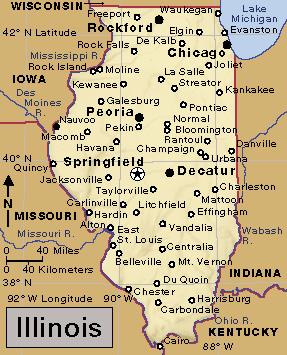
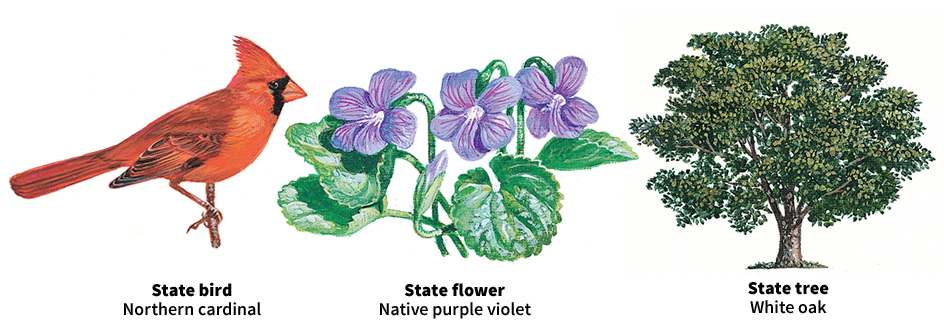

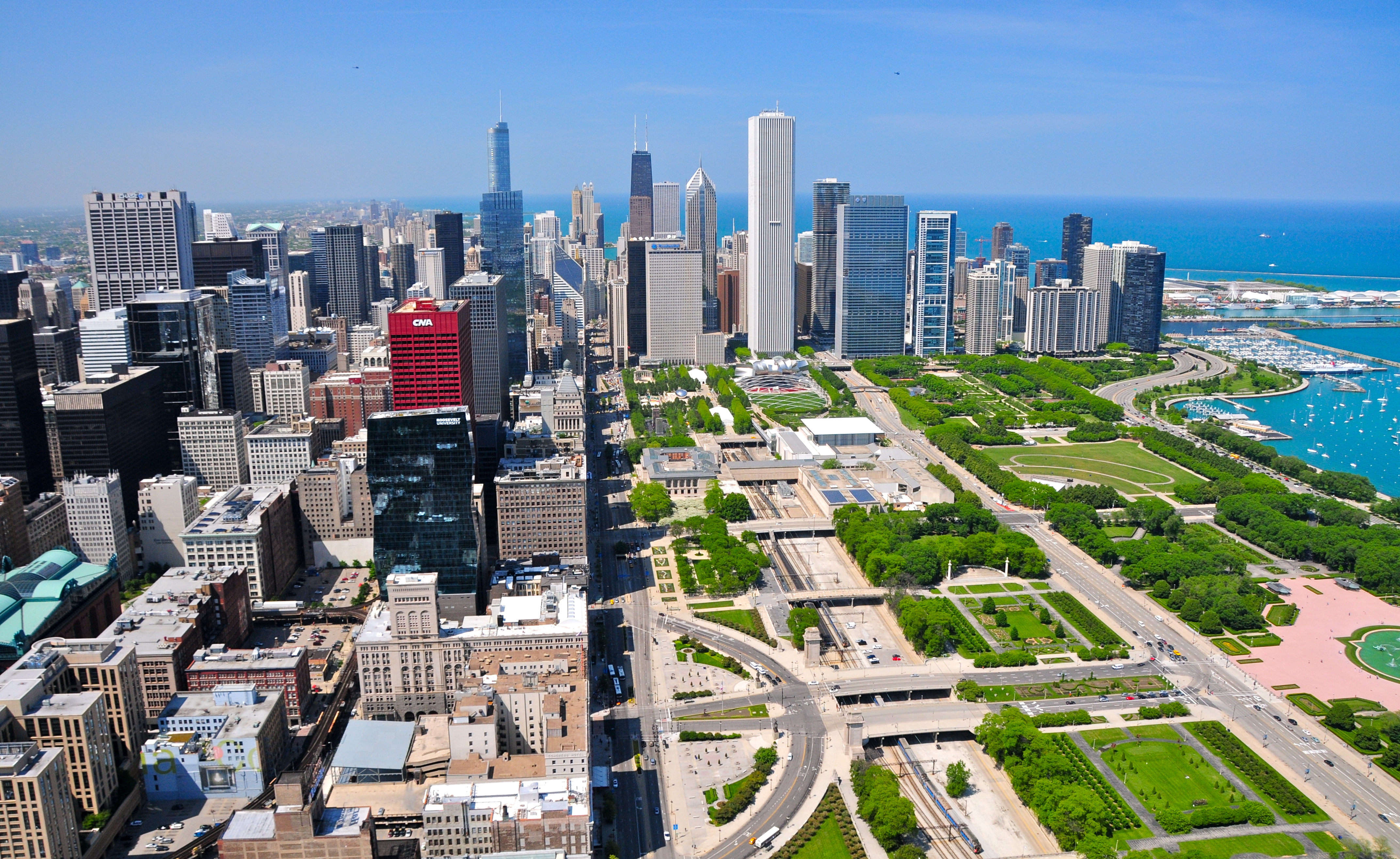
The people of Illinois also call their state the Land of Lincoln. They are proud of the fact that Abraham Lincoln, the 16th president of the United States, lived most of his life in their state. He was buried in Springfield, the state capital.
Many other famous people helped make history in Illinois. These people included industrialists Cyrus H. McCormick and George M. Pullman; writers Gwendolyn Brooks and Carl Sandburg; architects Louis Sullivan and Frank Lloyd Wright; reformers Jane Addams and Florence Kelley; and political leader Stephen A. Douglas. Ronald Reagan, the 40th president of the United States, was born in Tampico, Illinois. Chicagoan Barack Obama became the nation’s 44th president in 2009.
In 1942, Enrico Fermi and other scientists at the University of Chicago made a major advance in the development of the atomic bomb. In laboratories under the university’s football stands, they produced the first controlled chain reaction that created nuclear energy. Today, Illinois ranks as an international center for the study of the atom. Scientists from throughout the world come to the state to do research at the Fermi National Accelerator Laboratory. This laboratory, near Chicago, contains a number of particle accelerators, devices that accelerate particles of matter and cause them to collide.
The land of Illinois, part of the great Midwestern Corn Belt, has helped make the state rich. Illinois ranks among the leading states in agriculture. And beneath its fertile plains lie the country’s largest beds of bituminous (soft) coal. But most Illinois workers are employed in service industries, which include education, health care, and retail trade. Illinois also ranks among the top manufacturing states. Chemicals, machinery, and processed foods are among the leading manufactured products in Illinois.
The fur trade with the Osage and other Native American groups first made Illinois commercially important during the late 1600’s. Traders paddled canoes filled with furs down the Chicago River to Lake Michigan. The pelts were then transported in wooden sailing ships. Today, ocean freighters arrive from the Atlantic Ocean through the St. Lawrence Seaway and the Great Lakes, and carry Illinois products to many parts of the world. Busy river barges transport cargo on the Illinois Waterway, which links with the Mississippi River and the Gulf of Mexico.
The first Europeans in the Illinois region were probably the French explorers Louis Jolliet and Jacques Marquette, who arrived in 1673. The French settlers who came after Jolliet and Marquette named the region for the Illinois, or Illini, people. The Illinois formed a group of united tribes that lived in the area before the European settlers came. They called themselves Iliniwek (superior men). The name Illinois came from the French settlers’ spelling and pronunciation of Iliniwek.
People
Population.
The 2020 United States census reported that Illinois had 12,812,508 people. The population had decreased slightly compared to the 2010 census figure, 12,830,632. According to the 2020 census, Illinois ranks fifth in population among the 50 states.
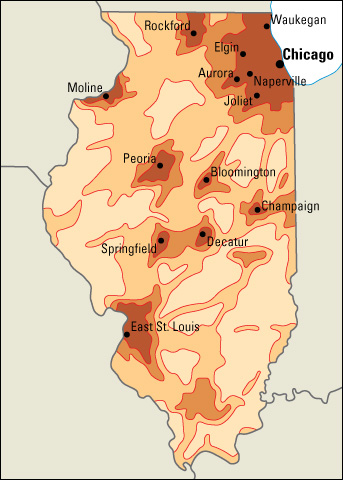
About 85 percent of the people of Illinois live within the state’s metropolitan areas. About two-thirds live in the Chicago-Naperville-Elgin metropolitan area. Twelve metropolitan areas are either partly or entirely in Illinois (see Metropolitan area).
Chicago is the largest city in Illinois. Other large Illinois cities, in order of population, include Aurora, Joliet, Naperville, Rockford, Elgin, and Springfield.
Most of the people of Illinois were born in the United States. Most of the people who were born outside the United States live in the Chicago area. About 15 percent of the state’s people are African Americans. About 20 percent are of Hispanic origin. People of English, German, Irish, Italian, Polish, and Swedish descent also make up large population groups.
Schools.
The first known Illinois school began in 1784 in Cahokia. Public schools did not become common until after 1825, when the legislature established the state’s public school system.
The governor appoints a State Board of Education to determine policies for public schools. The board appoints a state superintendent of education to supervise the school system. Illinois school districts are controlled by local elected school boards, except in Chicago, where the board is appointed. Children from age 6 through 16 must attend school.
Besides colleges and universities listed in the table in this section, Illinois has dozens of community colleges and a number of vocational schools. For the number of students and teachers in Illinois, see Education (table: U.S. students, teachers, and school expenditures).
Libraries.
The first public library in Illinois opened in 1818 in Albion. The largest public library in the state, the Chicago Public Library, opened in 1873. Other libraries in Chicago include the John Crerar Library, a world-famous scientific institution; and the Newberry Library, with collections on genealogy, history, and literature.
The Abraham Lincoln Presidential Library and Museum in Springfield has many books on Abraham Lincoln and on Illinois history. The Illinois State Library in Springfield serves libraries throughout the state.
Museums.
The Art Institute of Chicago has fine collections of French paintings of the late 1800’s and early 1900’s. The Kenneth C. Griffin Museum of Science and Industry in Chicago includes a realistic model of a coal mine. Chicago’s Adler Planetarium, dedicated in 1930, was the first planetarium in the Western Hemisphere. 
Other museums include the John G. Shedd Aquarium and the Field Museum, both in Chicago; and the Peoria Riverfront Museum. The Kohl Children’s Museum of Greater Chicago, in Glenview, specializes in hands-on exhibits and activities for young children. The Abraham Lincoln Presidential Library and Museum, in Springfield, houses one of the most diverse Lincoln and American Civil War collections in the United States. The Illinois State Museum in Springfield includes collections and exhibits in natural history and art. The Illinois Holocaust Museum & Education Center in Skokie tells the story of the millions of Jews and others murdered by the Nazis in the 1930’s and 1940’s.
Visitor’s guide
The fine recreation facilities of Illinois attract millions of visitors each year. Picnickers, hikers, and bicycle riders enjoy Cook County’s forest preserves and lakefront. Hunters shoot deer, pheasants, quail, rabbits, and turkeys in Illinois’s hunting grounds. Lake Michigan and many smaller lakes throughout the state are popular for boating, fishing, and swimming. The Mississippi, Ohio, and Wabash rivers, along the borders of Illinois, are major recreation sites. The Shawnee Hills of southern Illinois and the rolling hills of Jo Daviess County in northwestern Illinois have beautiful scenery.
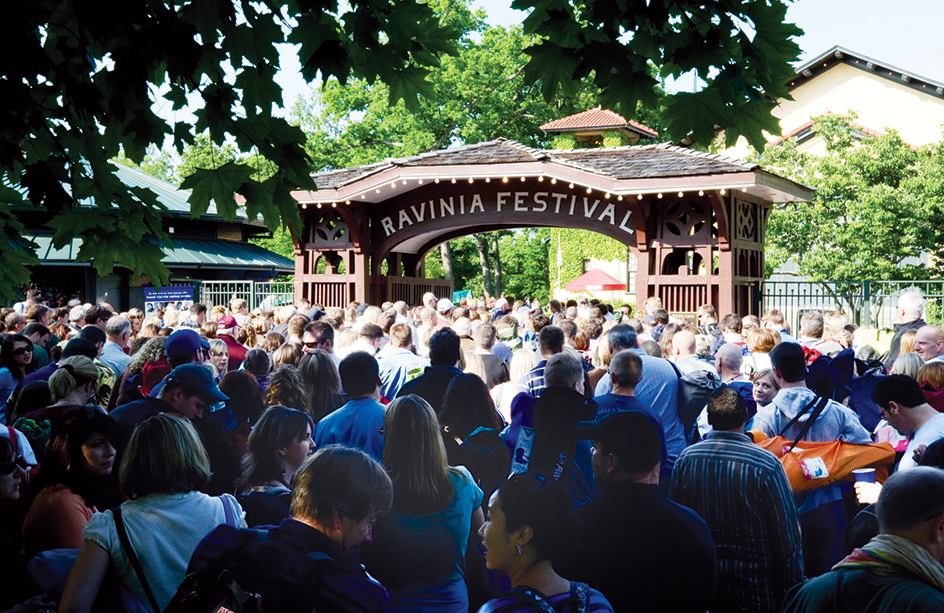
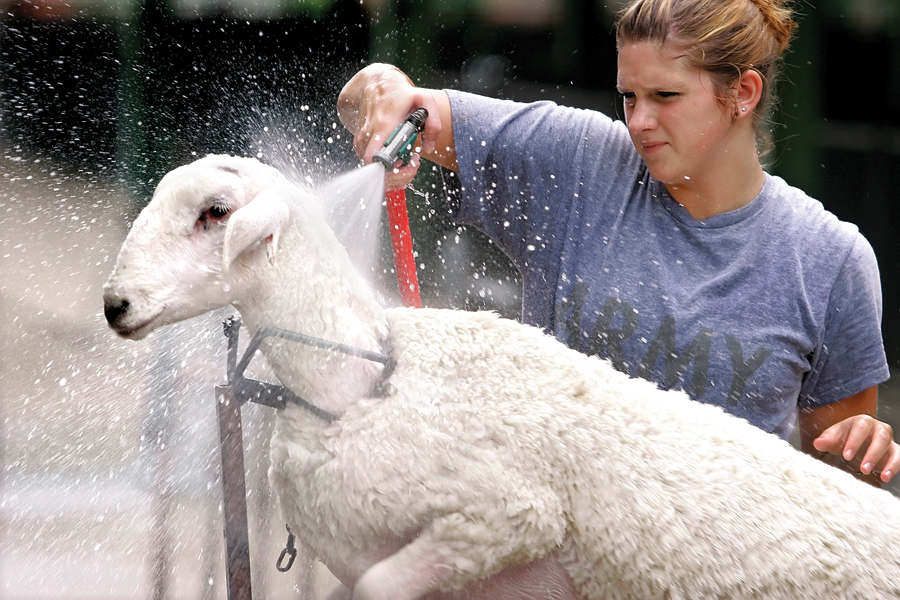
Chicago’s central location and its many fine hotels, restaurants, and municipal auditoriums make it a leading convention city. Sandy beaches, wooded parks, and yacht harbors border most of Chicago’s 30-mile (48-kilometer) shoreline along Lake Michigan.
Other Chicago attractions include two major league baseball teams, the Cubs of the National League and the White Sox of the American League. The city has a professional hockey team, the Blackhawks of the National Hockey League. Chicago also has a professional National Football League team, the Bears; and a professional National Basketball Association team, the Bulls.
Two state fairs—in Springfield during August and in Du Quoin in late August through early September—are among the most popular annual events in Illinois. The fairs feature automobile races, agricultural exhibits, performances by entertainers, and other attractions.
Land and climate
Land regions.
Illinois has five main land regions: (1) the Till Plains, (2) the Driftless Area, (3) the Great Lakes Plains, (4) the Shawnee Hills, and (5) the Gulf Coastal Plain.
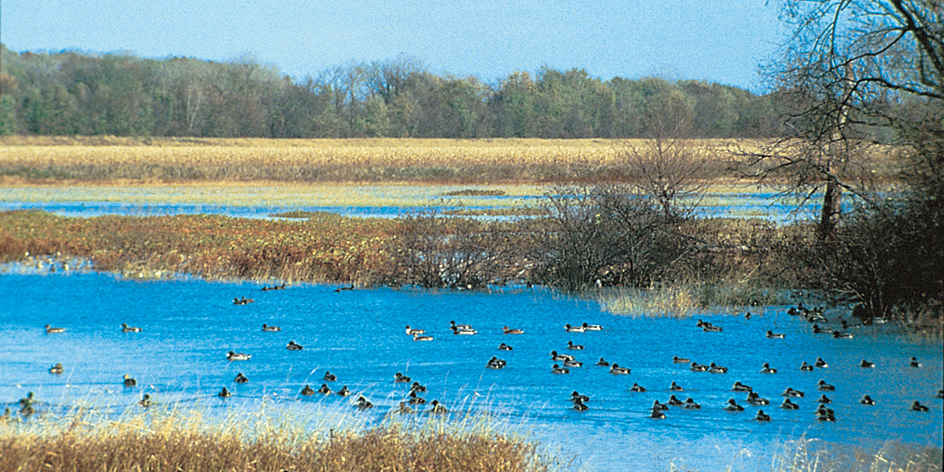
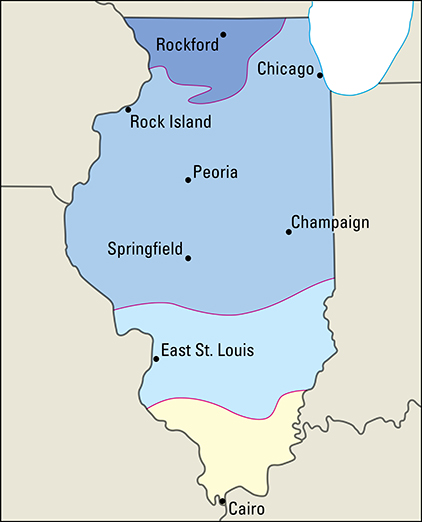
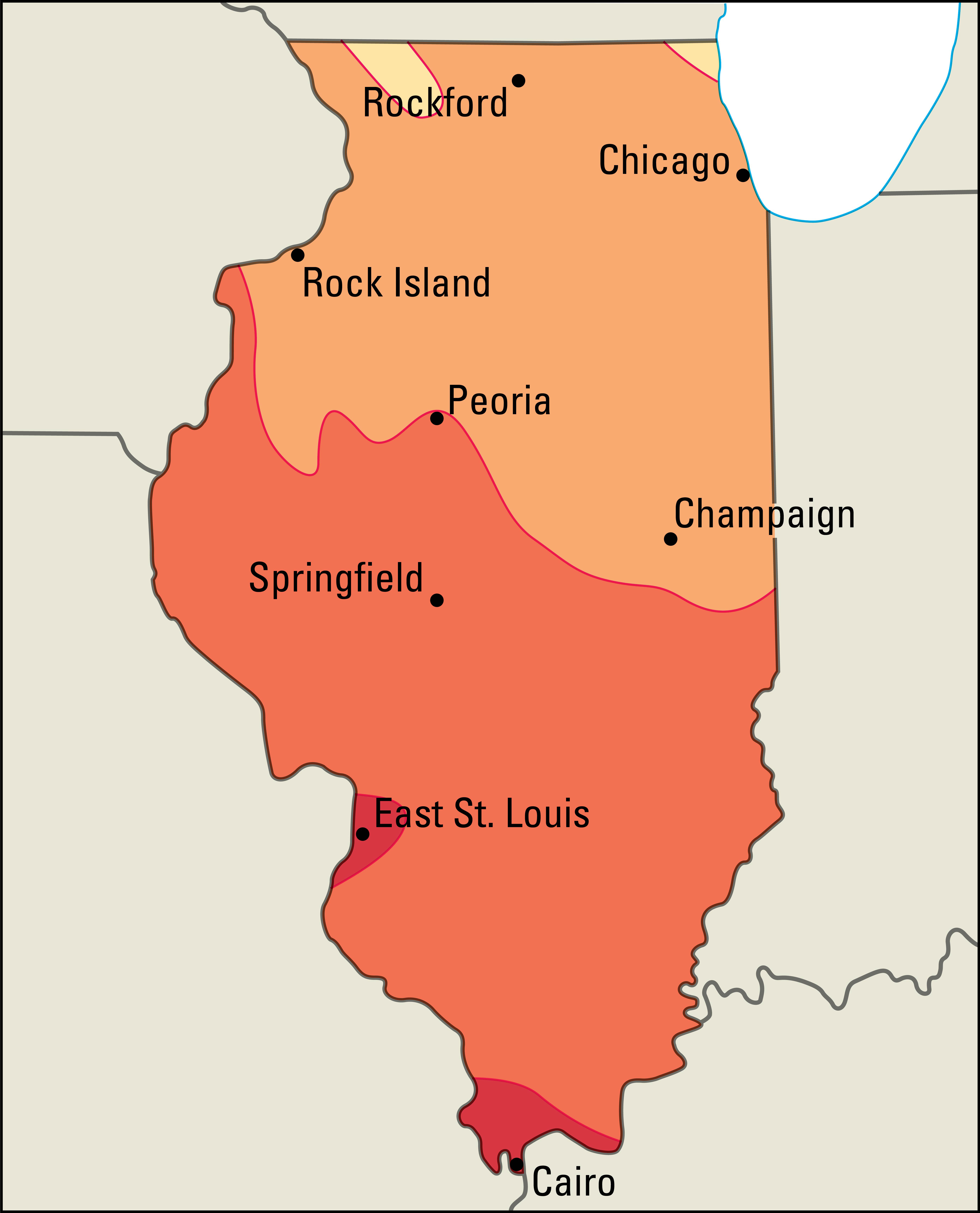
The Till Plains
cover most of Illinois. They are part of the fertile Interior Plains that extend across much of the Midwestern States. During the Ice Age, glaciers brought in materials that became soil and leveled most of the surface of this region (see Ice age). This action produced a gently rolling plain in most of what is now Illinois. Much of this plain was covered with prairie grass, which enriched the soil as it died and decayed. Today, the fertile black soil of the Till Plains makes this section the state’s most important farming area. The section is sometimes called the Garden Spot of the Nation. It is part of the Corn Belt that extends westward from Ohio to Kansas and Nebraska.
A part of the Till Plains was not touched by glaciers. This section lies between the Illinois and Mississippi rivers in Calhoun and Pike counties, in the west-central part of the state. Streams, ridges, and small hills break up this area. Orchards of apples and other fruits cover many of the slopes. Grain and hay are the chief crops.
The Driftless Area,
which covers most of Jo Daviess County in northwestern Illinois, is another section of the state that was not touched by glaciers. The Driftless Area has the state’s tallest hills and deepest valleys. Charles Mound (1,235 feet, or 376 meters), near Apple River, is the highest point in Illinois.
The Great Lakes Plains
cover the northeastern corner of Illinois. this section is the industrial and shipping region around Chicago. Lake Michigan once covered this area, which is now level with fertile soil. Small hills, lakes, and marshes appear north and west of the Chicago area.
The Shawnee Hills,
sometimes called the Illinois Ozarks, stretch across the southern part of the state for about 70 miles (110 kilometers). The width of the area varies from 5 to 40 miles (8 to 64 kilometers). The land ranges from 300 to 1,065 feet (91 to 325 meters) above sea level. It is a region of valleys, woods, river bluffs, and forested hills. Orchards thrive on many of the hills in this region of Illinois.
The Gulf Coastal Plain
of Illinois is the northern end of the plain that extends northward through the United States from the Gulf of Mexico. In Illinois, it covers the southern tip of the state. The northern part of this region is hilly, and the southern part is flat. Early settlers nicknamed this region Egypt, probably because the land between the Mississippi and Ohio rivers looks like the Nile Delta in Egypt. The lowest part of the state, which is 279 feet (85 meters) above sea level, lies in this area, along the Mississippi River.
Shoreline.
Illinois has 63 miles (101 kilometers) of shoreline on Lake Michigan. The gently curving shore does not provide any large natural harbors in Illinois. Several artificial harbors lie along the lakefront. The largest of these harbors are at Chicago and Waukegan. The land along the Illinois shore is mostly flat, and it includes many sandy beaches.
Rivers and lakes.
About 500 rivers and streams drain Illinois. The Mississippi River forms the entire western border of the state. The Illinois Waterway links Lake Michigan with the Mississippi River. This waterway includes the Chicago, Des Plaines, and Illinois rivers, plus a few canals.
The Illinois River, which is 273 miles (439 kilometers) long, is the largest river entirely within the state. With its branches, it drains about half of Illinois. The Sangamon River flows past Springfield to join the Illinois. The Spoon River, another tributary of the Illinois, was made famous by the poet Edgar Lee Masters in his Spoon River Anthology. The Rock and Fox rivers are known for their beautiful valleys.
The Wabash River flows along part of Illinois’ southeastern border. No part of the Ohio River is actually in Illinois, because the Kentucky boundary runs along the north shore of the river.
Lake Michigan forms the northeastern border of Illinois. Chain O’Lakes, a small group of lakes in northeastern Illinois, is a popular summer-resort area. It includes Fox Lake and also Grass Lake, which is covered in summer with blossoms of the American lotus.
Many Illinois counties have artificial lakes, ponds, and reservoirs. The largest artificial lake, Carlyle Lake, covers about 26,000 acres (10,500 hectares). Other large artificial lakes include Rend Lake and Crab Orchard Lake. Artificial lakes at Bloomington, Decatur, and Springfield supply water for these cities.
Plant and animal life.
Forests cover about 10 percent of Illinois. Most of the forests are in the southern part of the state or along rivers and streams. Important trees include cottonwoods, hickories, maples, oaks, and walnuts. Common wildflowers are bloodroot, dogtooth violets, Dutchman’s-breeches, and toothwort.
Animals in Illinois include beavers, deer, gray and red foxes, minks, muskrats, opossums, rabbits, raccoons, squirrels, and skunks. Game birds include ducks, geese, pheasants, and quail. One of the major feeding and resting grounds for wild ducks in North America is the Illinois River valley. There, about 2 million ducks may fly in during the spring and fall migrations. Several hundred thousand Canada geese spend the winter at bird sanctuaries on lakes in southern Illinois. The state also provides waterfowl sanctuaries along the Illinois and Mississippi rivers, and at Grass Lake in northeastern Illinois. Bass, buffalo fish, carp, catfish, perch, pike, and sunfish are among the fishes found in Lake Michigan and in the smaller lakes, rivers, and streams of Illinois.
Climate.
The weather of Illinois varies greatly from season to season, with cold winters and hot summers. The weather also may change sharply from day to day, especially in winter. Sometimes the temperature changes as much as 20 °F (11 °C) in an hour. These rapid changes in temperature are caused by winds that can sweep into the state from any direction, without mountains to block them. 
The coldest part of Illinois is the north, which has an average January temperature of 24 °F (–4 °C), and an average July temperature of 75 °F (24 °C). Southern Illinois averages 33 °F (1 °C) in January and 78 °F (26 °C) in July. The lowest temperature ever recorded in Illinois, –38 °F (–39 °C), occurred at Mount Carroll on Jan. 31, 2019. The highest temperature was 117 °F (47 °C), at East St. Louis on July 14, 1954.
Rainfall and snowfall vary within Illinois. Winds from the Gulf of Mexico bring most of the rainfall and snowfall. Southern Illinois averages 45 inches (114 centimeters) of precipitation a year, and northern Illinois has about 36 inches (91 centimeters). The northern part of Illinois has about 32 inches (81 centimeters) of snow a year, and southern Illinois gets about 12 inches (30 centimeters).
In northern Illinois, Lake Michigan influences Chicago area weather. The lake warms winds during winter and cools them in summer. Tornadoes have killed more people in Illinois than in any other state. The most destructive tornado, in March 1925, killed more than 600 Illinoisans, including 234 near Murphysboro.
Economy
Illinois has a diverse economy. Its access to Lake Michigan and the Mississippi River help make Illinois a leading transportation center. Illinois is also one of the nation’s leading manufacturing states. Service industries thrive in the state’s urban areas, especially in the Chicago area. Tens of millions of tourists visit Illinois each year, contributing tens of billions of dollars to the economy. Rich soil helps Illinois farmers make the state a leader in agricultural production.
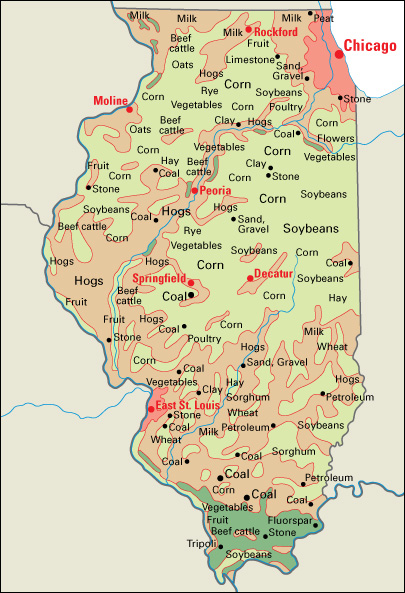
Natural resources.
The state’s most important natural resource is its fertile soil. Illinois also has valuable mineral deposits, including coal and petroleum.
Soil.
By the end of the most recent ice age about 11,500 years ago, glaciers had left a thick layer of material that became rich soil. This soil became even richer as prairie grass died and decayed for thousands of years before the first settlers arrived.
Minerals.
The state’s deposits of bituminous (soft) coal are its most important mineral resource. Coal beds lie under about two-thirds of the state. The richest coal deposits are in southern Illinois. The state also has deposits of peat, the first stage in nature’s formation of coal. The chief peat deposits are in the lake and swamp regions of northeastern Illinois.
Illinois also has large reserves of petroleum. The largest deposits are in the southeastern part of the state.
Large quantities of clay, limestone, sand and gravel, and sandstone are found in various parts of the state. Large deposits of silica sand lie near Ottawa. Alexander County has large reserves of tripoli, a chalky mineral used as a polishing powder for metal and glass.
Service industries
account for the largest portion of both Illinois’s employment and its gross domestic product—the total value of goods and services produced within the state in a year. Illinois’s service industries are concentrated in the Chicago metropolitan area.
Finance, insurance, and real estate are important to the state’s economy. Chicago is the financial capital of the Midwest. The city is the headquarters of the Seventh Federal Reserve District Bank, one of the 12 federal banks established by Congress. Chicago is also home to a large financial establishment called a commodities exchange. Commodities are basic goods that are bought and sold, such as grains and precious metals. The CME Group, which incorporates the former Chicago Board of Trade and Chicago Mercantile Exchange, is one of the largest commodities exchanges in the world. Large investment and insurance firms are also based in Illinois. These companies include the Allstate Corporation, HSBC Finance Corporation, and State Farm Mutual Automobile Insurance Company. Rapid population growth in Chicago’s suburbs has led to the development of a large number of new homes and businesses there. 
Many hotels, restaurants, and retail trade establishments operate in the Chicago area. The Chicago area is the home of retailers McDonald’s Corporation and Walgreen Co.
State government offices are based mainly in Springfield and Chicago. Downtown Chicago is home to such business services as accounting firms, advertising agencies, engineering companies, and law firms. Chicago’s Rush University Medical Center is one of the world’s largest medical complexes. Naval Station Great Lakes, a military base, is near North Chicago. Chicago is also one of the world’s leading transportation centers. One of the largest U.S. airlines, United Airlines, is headquartered in downtown Chicago. Large trucking and shipping companies are also based in the Chicago area.
Manufacturing.
Illinois is among the leading states in manufacturing. The Chicago area ranks among the nation’s leading manufacturing regions.
Chemicals are among the state’s leading manufactured products. Pharmaceuticals (medicinal drugs) are the leading chemical product of Illinois. Two leading pharmaceutical companies, Abbott Laboratories and Baxter International Inc., are headquartered near Chicago. Other chemical products made in Illinois include cleaning solutions, paint, and resins.
Processed foods are also important. Several of the nation’s largest food-processing companies are headquartered in the Chicago area. They include the Hillshire Brands Company, which is owned by Tyson Foods, and the Quaker Oats Company, which is owned by PepsiCo. The Chicago area is a leading food-processing center. The state’s chief food products include baked goods, breakfast cereals, candy, dairy products, meat products, and spices. Illinois is the home of the Archer Daniels Midland Company, a large processor of cereal grains and soybeans.
Fabricated metal products, machinery, and transportation equipment are also leading products. Illinois is a leading state in the production of fabricated metals. These products include metal stampings, machine shop products, and valves. Construction equipment and farm machinery provide much of the machinery income. Caterpillar, a company that ranks among the world’s major manufacturers of construction equipment, has headquarters in Deerfield and maintains major operations in Peoria. Deere & Company, a leading producer of farm machinery, is based in Moline. Illinois Tool Works, a maker of industrial machinery, is north of Chicago. Motor vehicles and motor vehicle parts are the leading transportation equipment manufactured in Illinois. Automobiles are manufactured in Belvidere, Chicago, and Normal. The Boeing Company, a leading airplane manufacturer, is headquartered in Chicago.
Illinois also manufactures computer and electronics products, petroleum products, plastics and rubber products, primary metal products, and printed materials. Joliet, Robinson, and Wood River have large petroleum refineries. Plastic products include bags, bottles, and pipes. Tires are the state’s leading rubber product. Steel, Illinois’s leading primary metal product, is produced in several areas of the state. The Chicago area ranks among the nation’s leading publishing centers. Large publishers based in the Chicago area include Encyclopædia Britannica, Inc.; Rand McNally; and World Book, Inc. R. R. Donnelley & Sons Company, a large printing company, is also based in Chicago.
Agriculture.
Illinois ranks among the leading states in farm income. Farmland covers about three-fourths of Illinois. Most of the agricultural income is generated in the northern half of the state. Crops account for about 85 percent of the state’s total agricultural income.
Corn has ranked as the chief crop of Illinois since pioneer days. Illinois ranks as a leading corn-producing state. Corn thrives throughout Illinois, but production is heaviest in the northern two-thirds of the state. Some of the corn is processed into ethanol, an alcohol that is used as an automobile fuel. 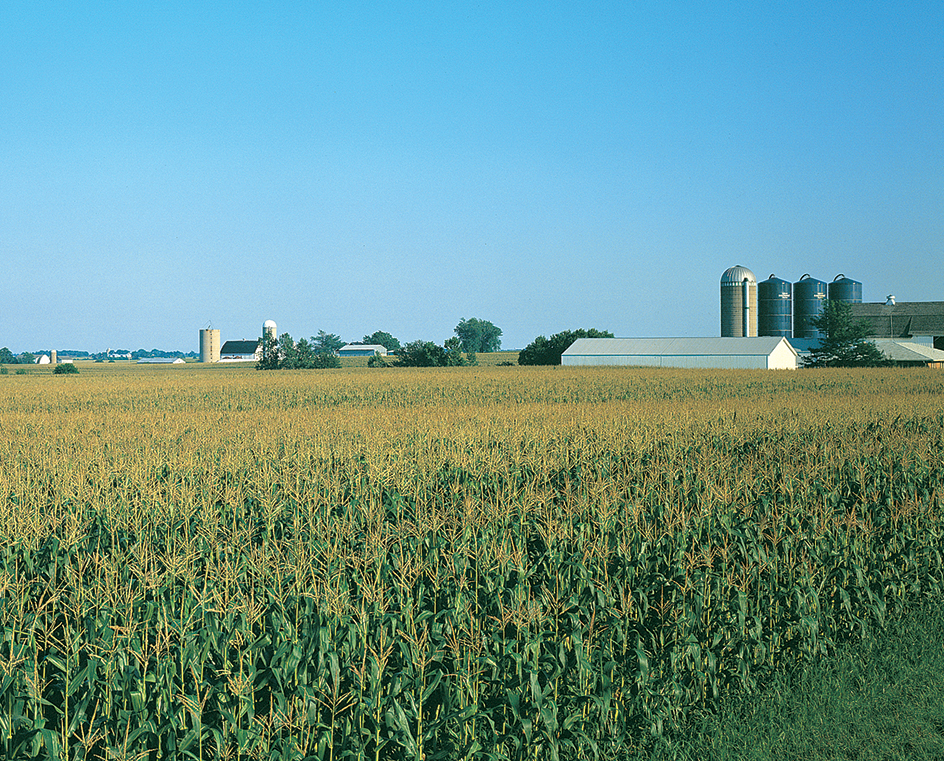
Soybeans are the state’s second most valuable farm product. Illinois is a leading soybean-producing state. Soybean production is heaviest in the east-central part of Illinois. Many farmers rotate corn and soybean crops in their fields from year to year. Wheat is also an important crop. The southern third of Illinois grows the most wheat. Farmers in Illinois also grow grain sorghum, hay, oats, and rye.
Beef cattle, hogs, and dairy products are the most valuable livestock products in Illinois. The chief cattle and dairy regions are the northwestern and western parts of the state. Illinois is a leading producer of hogs. West-central Illinois has many hog farms. Many hog farmers also raise corn, which they use as feed for their hogs. Other livestock products in Illinois include chickens, eggs, sheep, turkeys, and wool.
Illinois is an important producer of greenhouse and nursery products. Many of these products are grown in the Chicago area. Flowers grown in large quantities in Illinois for shipment to florists include chrysanthemums, gladioli, lilies, orchids, and poinsettias.
Most of the state’s vegetables come from the northern half of Illinois. Illinois ranks among the leading states in the production of sweet corn for canning and freezing. Illinois also ranks as a leading pumpkin-producing state. Other important vegetables grown in Illinois include cabbage, lima beans, peas, potatoes, and snap beans. Apples and peaches are the state’s most valuable fruit crops. The Mississippi and Illinois river valleys are the most productive fruit-growing regions in Illinois.
Mining.
Coal is the leading mined product. Most of the state’s coal comes from the southern half of the state. All of the state’s coal is of the bituminous (soft) variety. Franklin County is the leading producer of coal in Illinois.
Of the state’s other mineral products, limestone, petroleum, portland cement, and sand and gravel provide the largest amount of income. Limestone quarries primarily operate in northeastern Illinois. Most of the oil wells are in the southeastern part of the state. Sand and gravel are produced in approximately half of the state’s counties.
Electric power and utilities.
Nuclear power plants supply about half of the electric power generated in Illinois. Illinois is the country’s leading nuclear power producing state. Coal-burning plants supply most of the rest of the power.
Transportation.
The central location of Illinois and the state’s rich resources have helped make Chicago a leading transportation center of the United States.
O’Hare International Airport, in Chicago, is one of the world’s busiest airports. Chicago’s Midway International Airport is the second busiest airport in Illinois.
In 1856, the Illinois Central Railroad completed a line from Cairo to Dunleith (now East Dubuque), with a branch from Centralia to Chicago. The Illinois Central line ran approximately 700 miles (1,100 kilometers) and was the world’s longest single railroad at that time.
Today, railroads provide freight service throughout Illinois. Amtrak passenger trains serve about 30 of the state’s cities and towns. Several commuter lines link Chicago with its suburban areas and with cities in northern Indiana and southeastern Wisconsin.
Illinois has an extensive system of roads and highways. Twelve interstate routes and 22 U.S. highways cross Illinois. In the late 1950’s and early 1960’s, several expressways were built linking Chicago and its suburbs. At the same time, Chicago built the Chicago Skyway, an elevated highway that links the city with the Indiana Toll Road. The state built the Tri-State Tollway, which curves around Chicago and links Indiana with Wisconsin. The Jane Addams Memorial Tollway (formerly the Northwest Tollway) connects Chicago with Beloit and other Wisconsin cities.
Two great waterways serve Illinois—the Great Lakes and the Lakes-to-Gulf Waterway. The Great Lakes link Illinois with states to the east and the St. Lawrence Seaway. The Lakes-to-Gulf Waterway connects the Great Lakes with the Gulf of Mexico. It includes the Illinois Waterway, which links the Chicago, Des Plaines, and Illinois rivers to the Mississippi River. Chicago is one of the nation’s major ports.
Communication.
The first newspaper in what is now Illinois, the Illinois Herald, was started in Kaskaskia in 1814. Today, the leading newspapers in Illinois are the Chicago Sun-Times and the Chicago Tribune. Other daily newspapers in Illinois include the Daily Herald of Arlington Heights, the Journal Star of Peoria, the News-Democrat of Belleville, The Pantagraph of Bloomington, the Rockford Register Star, and The State Journal-Register of Springfield.
Government
Constitution
of Illinois was adopted in 1970, and it went into effect in 1971. The state had three earlier constitutions, adopted in 1818, 1848, and 1870. Constitutional amendments may be proposed by the state legislature. They must be approved by three-fifths of the members of each house. Then they must be approved by voters in a regular election, either by three-fifths of those voting on the proposal or by a majority of those voting in the election.
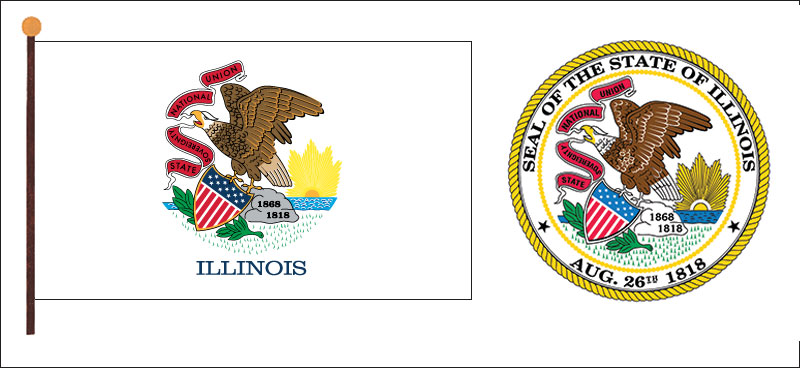
Amendments may also be proposed by a constitutional convention. A three-fifths vote in each house of the legislature is required to call a convention. The convention also must be approved by the voters in a regular election. The convention must receive approval either from three-fifths of all those who vote on the proposal or from a majority of all those who vote in the election. Amendments proposed by a convention must be approved in a special election. An amendment must get approval from a majority of the people who vote on it.
Executive.
The governor of Illinois and other key officials are elected to four-year terms. Other important state officials who are elected include the lieutenant governor, attorney general, secretary of state, comptroller, and treasurer.
Legislature
of Illinois is called the General Assembly. It consists of a Senate of 59 members and a House of Representatives of 118 members. 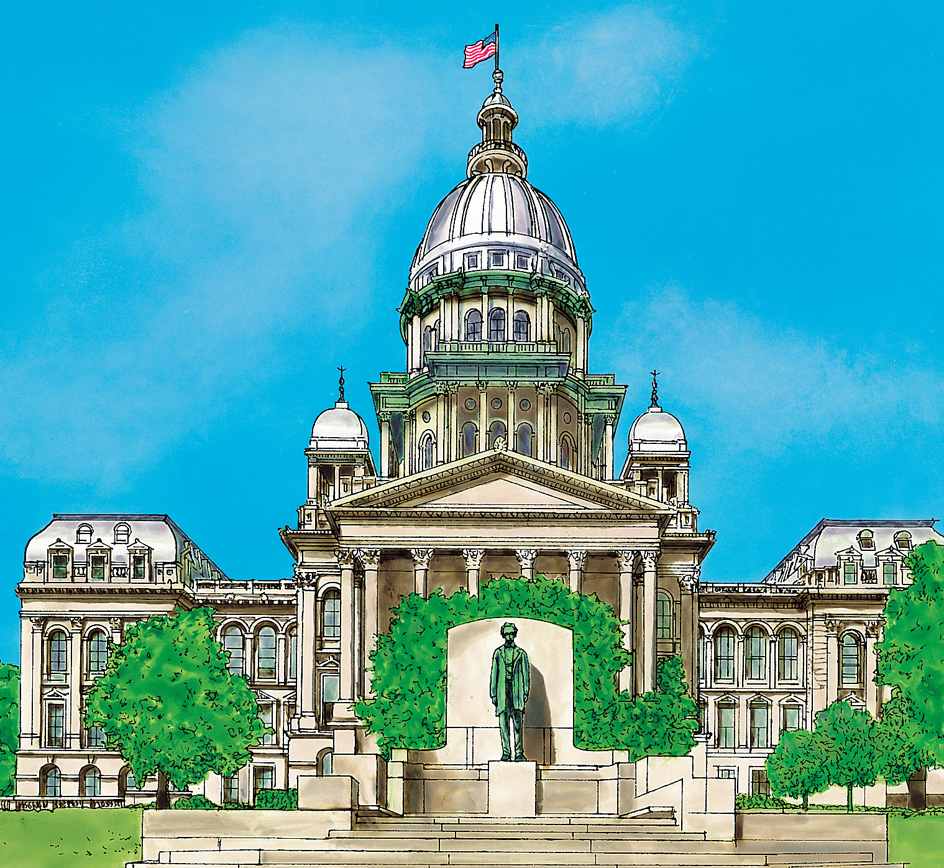
Voters in each of the state’s 59 legislative districts elect one senator. Senators serve terms of either two or four years. The legislative districts are divided into three groups for senatorial elections. Each group has a different combination of terms over a 10-year period. Each of the state’s 59 legislative districts is divided into two representative districts, and voters in each of these 118 representative districts elect one member of the House of Representatives. Representatives serve two-year terms.
The Illinois General Assembly begins its legislative sessions on the second Wednesday of every January. Legislative sessions have no time limit.
Courts.
The state’s court system consists of only three kinds of courts: (1) supreme, (2) appellate, and (3) circuit. Candidates for all judgeships run for office in the usual way. But judges run for reelection without opposition and serve another term if a majority of the voters approves their records.
The Supreme Court is the highest court. It has seven justices, elected to 10-year terms. Every three years, they elect one of their number chief justice. The Appellate Court has more than 50 judges, also elected to 10-year terms. The circuit courts are divided into 24 judicial circuits that have more than 900 circuit and associate judges. The circuit judges are elected to six-year terms. They appoint the associate judges to four-year terms. The Circuit Court of Cook County, the county that includes Chicago, is the largest court in the United States. It has more than 400 judges.
Local government.
Illinois has more units of local government than any other state. These include counties, townships, school districts, and districts formed for special purposes such as conservation or sanitation.
The state has 102 counties, most of which are divided into townships. Each county with townships, except for Cook County, is governed by a board of supervisors. These counties are divided into districts, and each district elects one supervisor to the board. Cook County is governed by a board of commissioners elected from districts. Counties without townships also are governed by an elected board of commissioners.
Illinois has more incorporated cities, towns, and villages than any other state—about 1,300. Most of the cities have a mayor-council form of government. Some of them have a council-manager system. The Constitution of Illinois grants home rule (self-government) to municipalities with populations of more than 25,000 and to counties with an elected chief executive. Important home-rule powers include the authority to borrow money and to levy taxes. But governments with home rule may not adopt taxes on earnings, income, or occupations without the permission of the General Assembly.
Revenue.
Taxation provides about 60 percent of IIllinois’s general revenue (income). Much of the rest of the state’s revenue comes from federal grants and programs. Also, the Illinois lottery provides hundreds of millions of dollars in revenue. The tax revenue sources include a general sales tax, license fees, and taxes on individual and corporate incomes, motor fuel, public utilities, and tobacco.
Politics.
Traditionally, Illinois voters have been divided about evenly between the Democratic and Republican parties. Many voters from Chicago and the state’s college towns are Democrats, and the majority of voters in the rest of the state are Republicans.
The Democratic organization of populous Chicago has great political power in the state. As a result, the Democrats have usually controlled the state House of Representatives. From the 1860’s to the 1970’s, downstate Republicans frequently controlled the state Senate. Democratic results in state Senate races have improved since the late 1900’s.
The voters have elected more Republicans as governor of Illinois than they have elected Democrats. Since the Republican Party was formed in 1856, Illinois has voted for Republican presidential candidates more often than Democratic candidates. Since the 1990’s, however, Illinois voters have favored Democratic presidential candidates.
History
Before European settlement.
The Illinois region was once the home of Native Americans who built burial and temple mounds. Several thousand of these prehistoric mounds still stand in the state. The group of mounds near Cahokia includes Monks Mound, the largest known prehistoric earthwork in the United States. See Mound builders.
Many of the later Native American groups of the region formed a union of tribes, including the Cahokia, Kaskaskia, Michigamea, Moingwena, Peoria, and Tamaroa. These tribes, called the Illinois Confederacy, belonged to the Algonquian family. The Iroquois attacked the Illinois tribes in 1680 and killed many of their members. By 1800, because of warfare and exposure to European diseases, only a few Illinois individuals remained. Other peoples that played a part in the early history of the region included the Chippewa, Fox, Kickapoo, Mascouten, Miami, Ottawa, Piankashaw, Potawatomi, Sauk (or Sac), Shawnee, and Winnebago. See Illinois.
French and British control.
In 1673, Father Jacques Marquette and Louis Jolliet set out to find and trace the Mississippi River. They were sent by Louis de Buade, Comte de Frontenac, the governor general of the French colonies in what is now Canada. Marquette and Jolliet were probably the first white men to enter the Illinois area. They traveled south along the western boundary of what is now Illinois, and they later traveled northward on the Illinois River. In 1675, Marquette founded a mission at a village of the Kaskaskia people near the present site of Ottawa.
In 1699, French priests founded a mission in Cahokia, a fur-trading post. This was the first permanent settlement in the Illinois region. Jesuit priests founded the colonial town of Kaskaskia in 1703. These two towns became the chief centers of French life in the area. For more than a hundred years, the Roman Catholic Church was the only active religious organization there. The first known Protestant preacher in Illinois was James Smith, a Baptist. Smith arrived in 1787. Joseph Lillard, a Methodist preacher, came to Illinois in 1793.
In 1717, Illinois became part of the French colony of Louisiana. That same year, John Law, a Scottish financial promoter in Paris, formed a company that brought some French colonists to Illinois (see Mississippi Scheme).
The French completed Fort de Chartres in 1720, northwest of Kaskaskia on the east bank of the Mississippi River. The fort was a stronghold for French villages in southwestern Illinois. In 1763, after a long war, the British won control of France’s North American empire. Native American nations of the Great Lakes region, who had been allies of the French, rebelled against British control. The Ottawa chief Pontiac played a major role in the rebellion but was unable to hold the nations together against the British (see Pontiac). Many French settlers in Illinois were unwilling to live under British control and moved west across the Mississippi into Spanish territory.
Early national period.
Fewer than 2,000 white people lived in the Illinois region before the American Revolution (1775-1783). They included missionaries, fur traders, French and British settlers, and British troops. George Rogers Clark of Virginia and a band of frontiersmen called the “Big Knives” captured Kaskaskia and Cahokia from British control in 1778. As a result, the region became a county of Virginia. Many soldiers who had helped Clark in this area returned as settlers after the war. Other settlers came from Kentucky, Maryland, Tennessee, and Virginia.
In 1784, Virginia gave the Illinois region to the national government. It did so because Maryland refused to ratify the Articles of Confederation unless Virginia and other states that held western lands gave them up. In the Northwest Ordinance of 1787, Congress made the Illinois region part of the Northwest Territory. In 1800, Illinois became part of the Indiana Territory by an act of Congress. See Articles of Confederation; Northwest Ordinance.
In 1809, Congress created the Illinois Territory from what is now Illinois and Wisconsin. Kaskaskia became the capital. President James Madison appointed Ninian Edwards of Kentucky the first territorial governor.
During the early 1800’s, the Indigenous (native) peoples of the region became more and more restless because the Illinois settlers were seizing so much of their land. After Congress declared war on the United Kingdom in the War of 1812, Native Americans sided with the British. The bloodiest Native American attack took place in August 1812 when about 100 soldiers and settlers were withdrawing from Fort Dearborn, at the mouth of the Chicago River. The Potawatomi killed more than half of the group. See Fort Dearborn.
Early statehood.
Illinois became the 21st state of the Union on Dec. 3, 1818. At that time, only the southern third of the state was settled. The Northwest Ordinance had fixed the northern boundary of the future state of Illinois at a line west from the southern tip of Lake Michigan. 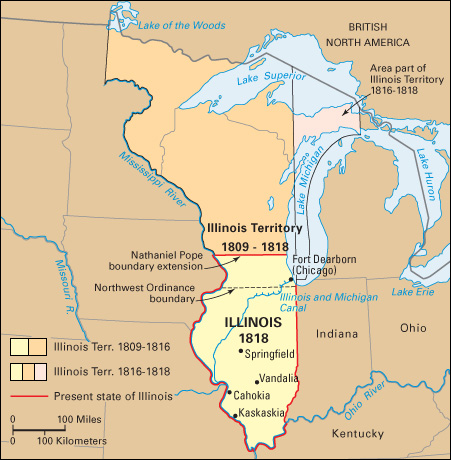
Nathaniel Pope, the territorial delegate to Congress, succeeded in having the northern border extended to the present northern boundary of Illinois. This change brought the Chicago area, the lead deposits around Galena, and the rich northern dairy section into the state. Otherwise, these regions would lie in the present state of Wisconsin. Almost two-thirds of the people of Illinois now live in the area added as a result of Pope’s urging. In 1818, voters elected Shadrach Bond, a Democratic-Republican, as the first governor of Illinois.
In 1819, the legislature established the town of Vandalia as the future capital. The state planned to profit by selling lots there. Vandalia became the capital in 1820, with the agreement that it would remain so for 20 years.
Settlers began moving into the northern section of Illinois about 1825. That year, the Erie Canal opened across New York, and travel to the Middle West became easier. The population of Illinois grew from 55,000 in 1820 to 157,000 in 1830. The federal government moved many of the Indigenous peoples of Illinois west across the Mississippi River during the 1830’s. In 1832, the Army and Illinois militiamen defeated the Sauk and Fox in the Black Hawk War (see Black Hawk). The state then began to develop rapidly. 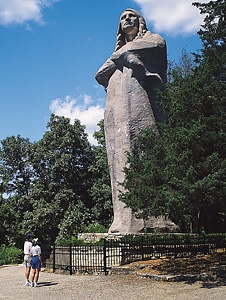
During the 1830’s, many immigrants arrived from all parts of Europe. They farmed the land, helped build railroads, and worked in the state’s factories and mines. After 1836, many Irish came to work on the Illinois and Michigan Canal, between Chicago and La Salle. Many Illinois residents were land speculators during the mid-1830’s. They bought their land expecting it to become valuable as towns grew up on it.
In 1837, the question of where to locate the new capital arose in the legislature. Several cities wanted to be the capital. The delegation from Sangamon County, headed by Abraham Lincoln, succeeded in having Springfield chosen as the capital. The state offices were moved there in 1839.
In 1848, work was completed on the Illinois and Michigan Canal. This canal allowed farmers in the Mississippi and Illinois river valleys to ship grain and other products to eastern markets by way of the Great Lakes. During the 1850’s, rail lines were extended to carry farm products to market. The railroads also linked such cities as Chicago, Cairo, and Quincy.
The Civil War.
Illinois attracted nationwide attention in 1858 because of the debates between Abraham Lincoln and Stephen A. Douglas. The two men were campaigning for the U.S. Senate. Lincoln lost the election, but his stand on slavery led to national recognition and to his election as president of the United States in 1860. After Lincoln’s election, six Southern States seceded from the Union. The American Civil War (1861-1865) broke out after Lincoln’s inauguration. See Lincoln, Abraham (The debates with Douglas). Loading the player...
Abraham Lincoln
In the early days of the Civil War, many Confederate sympathizers lived in southern Illinois. Some of them talked of establishing a separate state. But most of the people of Illinois favored the Union. President Lincoln came from Illinois, and so did Union general Ulysses S. Grant. About 260,000 Union soldiers came from Illinois.
Industrial development
in Illinois made great progress after the Civil War. Railroad construction increased. The state’s growing industries attracted European immigrants to the factories, forges, and mills of such cities as Chicago, Joliet, and Rockford. Chicago became the largest grain and meat-packing center in the United States. In 1871, the Chicago Fire destroyed much of the city (see Chicago (History)). 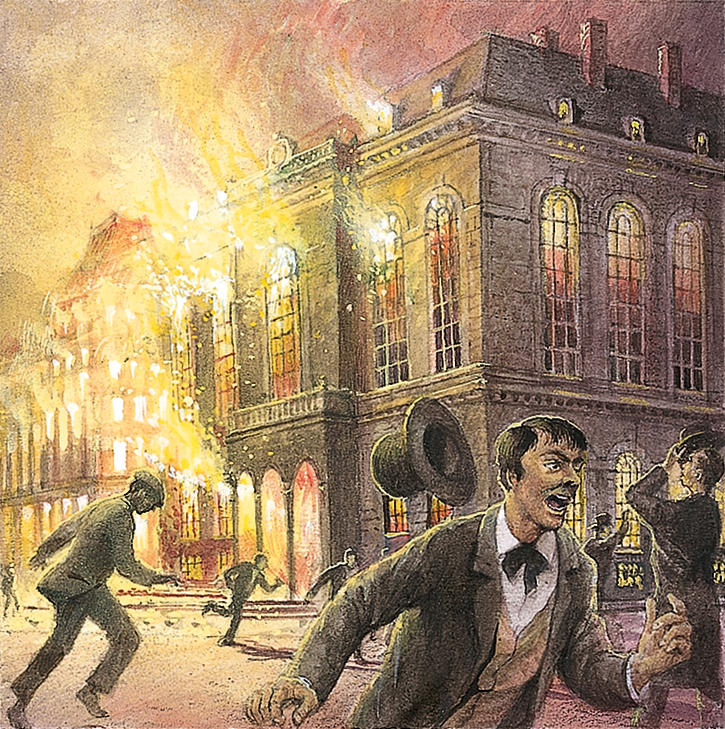

After 1870, huge areas of Illinois were drained and made into productive farmland. From the late 1860’s to the 1890’s, farmers and industrial workers throughout the country became discontented. Farmers were dissatisfied with paying high prices for equipment and shipping, while getting low prices for crops. Industrial employees had to work long hours, frequently in unhealthful and unsafe conditions. In 1886, a riot occurred at Chicago’s Haymarket Square.
Someone threw a bomb during a meeting organized by anarchists to protest police tactics against striking workers. At least seven policemen and one civilian died as a result. The role that the anarchists played in the riot temporarily weakened support for the labor movement. See Anarchism; Haymarket Riot.
In 1892, farmers joined with city workers to elect Governor John P. Altgeld. His administration enforced laws on factory inspection and established a state board to help settle strikes. The state also improved the public school system and passed industrial and prison reforms.
The World’s Columbian Exposition took place in Chicago in 1893. It was held during one of the nation’s worst depressions of the 1800’s. The depression ended by 1898, and Illinois industry then grew rapidly. By 1900, over half the people worked in cities.
In 1900, engineers completed the Chicago Sanitary and Ship Canal. This canal connected Lake Michigan with the Des Plaines River, by way of the Chicago River. The purpose of the canal was to prevent waste in the Chicago River from flowing into Lake Michigan and polluting the city’s water supply. Construction of the canal caused the river to flow backward, away from the lake.
The early 1900’s.
Illinois was one of the most progressive states during the national reform era from the early 1890’s to the late 1910’s. The legislature passed several laws limiting the long working hours of women and children. In 1911, Illinois passed the country’s first statewide law establishing payments from public funds to poor parents for the care of their children. 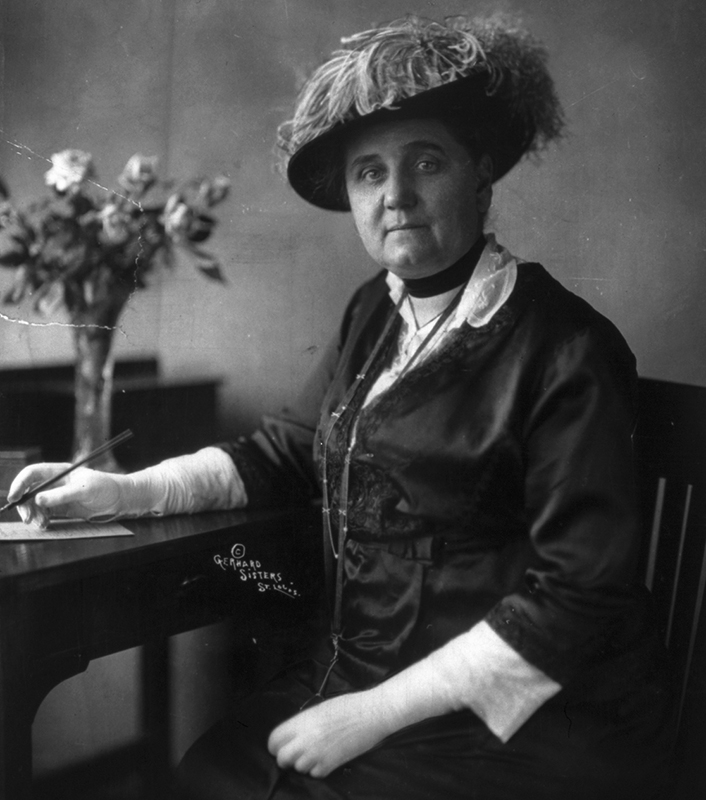
During the early 1900’s, thousands of African Americans from the Deep South moved to Illinois. The new migrants were encouraged to move by the Chicago Defender, a Black newspaper. Good rail connections contributed to the shift. Perhaps two-thirds of the Black migrants settled in a district of Chicago called Bronzeville. However, all Illinois cities had growing African American communities. Three race riots—occurring in Springfield in 1908, in East St. Louis in 1917, and in Chicago in 1919—brought national attention to Illinois. The first of these riots led directly to the founding of the National Association for the Advancement of Colored People (NAACP). See National Association for the Advancement of Colored People (NAACP).
After the United States entered World War I in 1917, Illinois became one of four states to furnish men for an entire Army division. This division was the 33rd, or Prairie, Division. Illinois also furnished many other servicemen. The Navy trained about 125,000 men at the Great Lakes Naval Training Center (now Naval Station Great Lakes), and Fort Sheridan turned out more than 5,000 Army officers.
Prohibition and the Great Depression.
Years of crime and violence in Chicago followed the federal prohibition of liquor manufacture and sales during the 1920’s. Al Capone headed a $60-million-a-year illegal liquor ring. Many men died in the gang warfare between Capone’s mob and rival gangs. Prohibition also led to violence in the southern part of the state, especially in Williamson County. Members of the Ku Klux Klan, a group of white secret societies, conducted raids against saloons and private homes. After the Klan lost power, the bootleggers fought among themselves for territory, much as Chicago gangsters did. See Capone, Al; Prohibition. 
Industrial production in Illinois increased during the 1920’s. Railways, waterways, and hard-surfaced roads were expanded, and cities grew rapidly. But prices of farm products dropped so low that many farmers had to give up their farms. During the 1930’s, farm-mortgage acts and other federal programs helped farmers recover.
The Great Depression of the 1930’s caused a sharp decrease in manufacturing, and thousands of people lost their jobs. Governor Louis L. Emmerson called a special session of the legislature in 1932 to establish funds for unemployment relief. The Century of Progress Exposition was held in Chicago in 1933 and 1934.
In 1933, the Illinois Waterway was opened. This series of canals and rivers expanded water traffic between Lake Michigan at Chicago and the Mississippi River. In 1937, the discovery of new oil fields brought an oil boom to southeastern Illinois.
The mid-1900’s.
The nuclear age began with the development of the atomic bomb during World War II (1939-1945). A major step in that work came when Enrico Fermi and other scientists at the University of Chicago set off the first controlled nuclear chain reaction. During the war, Illinois had thousands of war plants, including more than 800 aircraft and aircraft-parts factories. 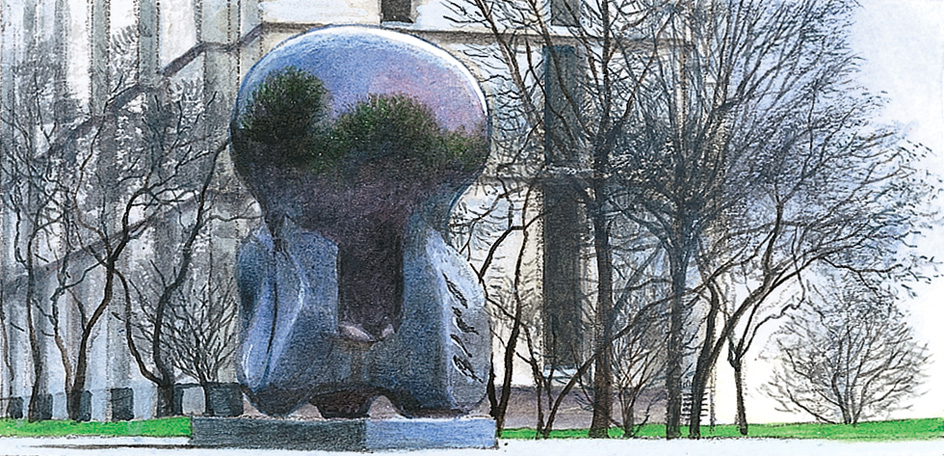
In the 1950’s, the Argonne National Laboratory, near Chicago, became the leading U.S. research center in industrial uses of nuclear energy. In 1956, a nuclear reactor for industrial research was built at the Illinois Institute of Technology in Chicago. By 1960, the Chicago area had become the nation’s largest steel producer.
During the 1960’s, Illinois worked to attract new industries and expand existing ones. In 1960, one of the nation’s largest electric-power nuclear reactors was completed at Morris. Several hundred new factories, including automobile and tire plants, went into operation. Expanded industries included the manufacture of chemicals and steel for the U.S. space program.
The battle between Democrats and Republicans for control of the state government reached an unusual climax in the 1960’s. Under the Illinois constitution, the legislature must be reapportioned (redivided) every 10 years to provide more equal representation based on population. But in 1963, the two parties could not agree on a reapportionment plan. The main problem was the redistricting of Cook County, which included 30 of what were then the state’s 59 legislative districts. Chicago, the center of Democratic power, had 23 of these districts. Republicans argued that one of their own centers of strength, Chicago’s suburbs, should have two more Cook County districts. But Chicago refused to give up two districts. As a result, all districts were suspended for the 1964 elections. Representatives were elected at large (by voters from throughout the state).
The legislature again failed to reapportion itself in 1965. Therefore, a panel of judges reapportioned the Senate, and a special commission reapportioned the House of Representatives. The number of legislative districts in both Chicago and its suburbs was increased.
In 1964, a constitutional amendment streamlining the Illinois court system went into effect. The system now consists of three kinds of courts—supreme, appellate, and circuit. The state abolished all lower courts and expanded the duties of the circuit courts.
In 1968, work began on the Fermi National Accelerator Laboratory in Batavia. The laboratory went into operation in 1972, and scientists and engineers from throughout the world conduct high-energy physics research there. The laboratory is one of the world’s leading centers for study of the atom. 
In 1969, the Illinois legislature approved individual and corporate state income taxes for the first time. In 1970, Illinois voters approved a new state constitution. The new constitution went into effect in 1971, replacing the constitution that had been adopted in 1870.
The late 1900’s.
Illinois’s industrial and population growth during the 1960’s brought problems as well as benefits. The industrial expansion led to increased air and water pollution. The population growth created a need for more public services and led to higher taxes. In 1973, the legislature adopted a lottery to help raise revenue for education and other services.
Illinois continued to thrive industrially, with Chicago the center of activity. During the 1980’s and 1990’s, Illinois experienced substantial growth in high-technology industries in the area around Cook County that includes Lake, DuPage, and Will counties.
The death penalty.
In early 2000, Governor George Ryan declared a moratorium (temporary halt) on the death penalty in Illinois and called for a review of the capital punishment system. He said he wanted to make sure that innocent people were not being put to death. Illinois had reinstated capital punishment in 1977. Since that time, 13 people who were sentenced to die were found to have been wrongfully convicted. In 2002, Ryan submitted to Illinois lawmakers proposals to overhaul the state’s capital punishment system.
In January 2003, just before his term as governor ended, Ryan commuted (reduced) the sentences of all 167 Illinois prisoners on death row. Death row is where people who have been sentenced to death await execution. In November 2003, the legislature approved sweeping reforms of the capital punishment system. However, Rod Blagojevich, who succeeded Ryan, continued the moratorium on the death penalty. Lieutenant Governor Pat Quinn succeeded Blagojevich as governor in 2009. In March 2011, Quinn signed legislation abolishing the death penalty in Illinois. At the time, he also commuted the sentences of the 15 men remaining on death row.
Corruption cases.
In 2003, a federal grand jury indicted Ryan on 18 charges, including racketeering conspiracy, mail fraud, and filing false tax returns. Most of the charges were related to the time Ryan served as Illinois secretary of state, from 1991 to 1999. The racketeering charge accused Ryan of conspiring to use his office to grant political favors and state contracts to associates for personal gain. In 2006, a jury convicted Ryan of all charges against him. Ryan served a sentence of 61/2 years in prison.
In 2008, Senator Barack Obama, a resident of Chicago, was elected president of the United States. Obama resigned his U.S. Senate seat soon after the election. Governor Blagojevich was to appoint a successor to Obama as senator, but federal authorities arrested the governor on corruption charges before he could do so. Prosecutors accused him of planning to “sell or trade” the Senate seat “for financial and personal benefits for himself and his wife.” Blagojevich denied any wrongdoing. In response to the charges, state officials and Democrats in the U.S. Senate said they would refuse to seat anyone the governor appointed. However, in December 2008, Blagojevich named Roland Burris, a former state comptroller and attorney general, to fill the seat, arousing much controversy. Weeks later, Senate Democrats dropped their objection to Burris, and Burris joined the Senate.
In 2009, the Illinois House of Representatives impeached Blagojevich for abusing his power. The state Senate voted unanimously to remove him from office. It was the first time in Illinois history that a governor was impeached. Pat Quinn, who was then lieutenant governor, succeeded him. Federal prosecutors indicted Blagojevich and some of his aides on charges of conspiracy, fraud, and attempted extortion. After an 11-week trial, the jury found Blagojevich guilty in 2010 of just one count of lying to federal agents. Jurors deadlocked on 23 other counts against him, and the judge declared a mistrial on those charges. A second trial began in 2011. The jury found Blagojevich guilty of 17 out of 20 federal corruption charges, including all charges tied to attempts to trade Obama’s Senate seat. A federal judge sentenced the former governor to 14 years in prison. In 2015, a federal appeals court overturned the convictions on five of the corruption counts against Blagojevich. However, the same federal judge who imposed the original sentence on Blagojevich declined to reduce it. In 2020, President Donald J. Trump commuted (reduced) Blagojevich’s sentence, and the former governor was released from prison.
The early 2000’s.
During the first part of the 2000’s, Illinois faced a daunting budget crisis. In 2011, the state legislature passed a law temporarily increasing corporate and personal income tax rates. In 2015, tax rates fell to nearly pre-2011 levels as the law required.
In 2014, Republican Bruce Rauner was elected governor. His platform included cutting spending, fixing the state’s underfunded pension system, and curbing the rights of unions. He soon clashed with the state’s Democratic-controlled legislature, and for more than two years, the two sides were unable to agree on a budget. By 2017, the state had more than $15 billion in unpaid bills, and it was forced to make deep cuts in spending on education and social services. In July, the state House and Senate, with the support of a number of Republican legislators, passed a budget that included increases in personal and corporate income tax rates. The legislature then overrode Rauner’s veto of the budget plan. In 2018, J. B. Pritzker, a Democrat, defeated Rauner in a campaign for Illinois governor. Pritzker took office in 2019. He was reelected in 2022.
COVID-19 crisis.
In early 2020, Illinois became one of many states facing a public health crisis due to the COVID-19 pandemic (global epidemic). COVID-19, a contagious respiratory disease, had begun spreading through communities worldwide after first appearing in China in late 2019. In late January 2020, Illinois announced its first confirmed case of COVID-19. In March, infections with the virus that causes the disease rose sharply in Illinois, especially in Chicago and the surrounding metropolitan area. In mid-March, Governor Pritzker ordered all schools to close. Soon afterward, he issued a stay-at-home order and directed nonessential businesses to close. The order compelled residents to remain at home, except under limited circumstances.
In May 2020, authorities relaxed some limits on business activity in many parts of the state. In June in Chicago, restaurants and other businesses previously classified as nonessential were allowed to reopen, with restrictions. Restrictions were further relaxed later in the summer. However, rising numbers of COVID-19 cases in the fall and winter prompted state and local officials to increase restrictions again.
In late 2020 and early 2021, health care workers and elderly Illinoisans began to receive COVID-19 vaccines. Vaccines became available to all Illinois adults during the spring of 2021. Higher vaccination rates led to lower rates of severe cases, but the spread of highly contagious variants of the virus led to further outbreaks. By early 2023, about 4 million people in Illinois were confirmed to have been infected with the virus, and more than 40,000 had died from COVID-19.
